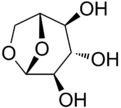Levoglucosan
Levoglucosan (C6H10O5) is an organic compound with a six-carbon ring structure formed from the pyrolysis of carbohydrates, such as starch and cellulose.[1] As a result, levoglucosan is often used as a chemical tracer for biomass burning in atmospheric chemistry studies, particularly with respect to airborne particulate matter. Along with other tracers such as potassium, oxalate, and gaseous acetonitrile,[2] levoglucosan has been shown to be highly correlated with regional fires. This is because the gas emitted by the pyrolysis of wood (biomass) contains significant amounts of levoglucosan.
 | |
 | |
| Names | |
|---|---|
| IUPAC name
(1R,2S,3S,4R,5R)-6,8-Dioxabicyclo[3.2.1]octane-2,3,4-triol | |
| Other names
1,6-Anhydro-beta-glucopyranose
Leucoglucosan | |
| Identifiers | |
3D model (JSmol) |
|
| 80998 | |
| ChEBI | |
| ChemSpider | |
| ECHA InfoCard | 100.007.142 |
| EC Number |
|
| MeSH | 1,6-Anhydro-beta-glucopyranose |
PubChem CID |
|
| UNII | |
CompTox Dashboard (EPA) |
|
| |
| |
| Properties | |
| C6H10O5 | |
| Molar mass | 162.141 g·mol−1 |
| Appearance | Colorless crystals |
| Density | 1.688 g·cm−3 (predicted) |
| Melting point | 182 to 184 °C (360 to 363 °F; 455 to 457 K) |
| Boiling point | 384 °C (723 °F; 657 K) predicted |
| log P | -0.04 (predicted) |
| Vapor pressure | 24.1 μPa (predicted) |
| Hazards | |
| Flash point | 185.9 °C (366.6 °F; 459.0 K) (predicted) |
Except where otherwise noted, data are given for materials in their standard state (at 25 °C [77 °F], 100 kPa). | |
| Infobox references | |
Levoglucosan has been described as "an unequivocal biomass burning tracer" in the context of forest and brush fires.[3] But the anhydrosugar has only been found detectable in low temperature samples (150-350 °C), meaning that its value as an indicator for smoke from controlled biomass combustion in, for instance, modern domestic wood stoves which operate at temperatures above 500 °C, is "very doubtful".[4] Levoglucosan is a marker for coal combustion as well as wood.[5]
The hydrolysis of levoglucosan generates the fermentable sugar glucose. Levoglucosan can be utilized in the synthesis of chiral polymers such as unhydrolysable glucose polymers.
References
- Lakshmanan, Chambra M.; Hoelscher, Harold E. (1970). "Production of Levoglucosan by Pyrolysis of Carbohydrates. Pyrolysis in Hot Inert Gas Stream". Industrial & Engineering Chemistry Product Research and Development. 9: 57–59. doi:10.1021/i360033a011.
- Aiken, A. C.; De Foy, B.; Wiedinmyer, C.; Decarlo, P. F.; Ulbrich, I. M.; Wehrli, M. N.; Szidat, S.; Prevot, A. S. H.; et al. (2010). "Mexico city aerosol analysis during MILAGRO using high resolution aerosol mass spectrometry at the urban supersite (T0) – Part 2: Analysis of the biomass burning contribution and the non-fossil carbon fraction" (PDF). Atmospheric Chemistry and Physics. 10 (12): 5315. doi:10.5194/acp-10-5315-2010.
- "Identification of biomass burning tracers" (PDF). Euro 'Milestone' Survey. Retrieved 20 March 2015.
- Harrison, Roy M.; Beddows, David C.S.; Jones, Alan M.; Calvo, Ana; Alves, Célia; Pio, Casimiro (2013). "An evaluation of some issues regarding the use of aethalometers to measure woodsmoke concentrations" (PDF). Atmospheric Environment. 80: 540–548. doi:10.1016/j.atmosenv.2013.08.026.
- Yan, Caiqing; Zheng, Mei; Sullivan, Amy P.; Shen, Guofeng; Chen, Yingjun; Wang, Shuxiao; Zhao, Bin; Cai, Siyi; Desyaterik, Yury; Li, Xiaoying; Zhou, Tian; Gustafsson, Örjan; Collett, Jeffrey L. (2018). "Residential Coal Combustion as a Source of Levoglucosan in China". Environmental Science & Technology. 52 (3): 1665–1674. doi:10.1021/acs.est.7b05858. PMID 29244948.